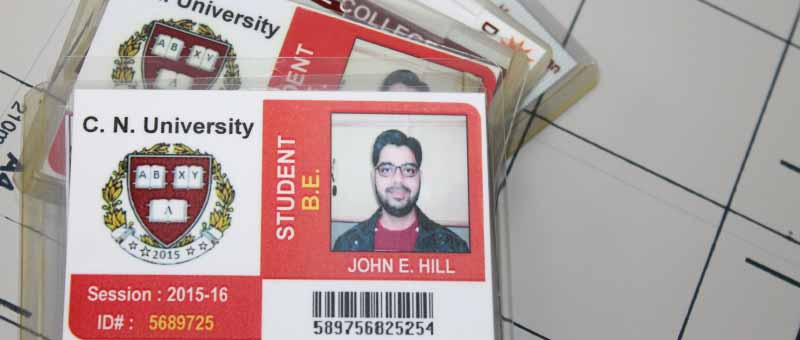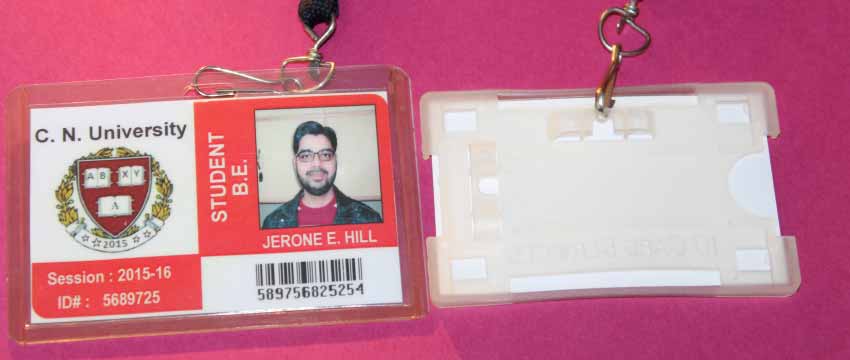Legal Considerations to Keep in Mind when Designing a Student ID Card
-
Privacy Laws:
Ensure that your student ID card design complies with applicable privacy laws. This may include regulations such as the General Data Protection Regulation (GDPR) in the European Union or the California Consumer Privacy Act (CCPA) in California, USA. Pay attention to how personal information is collected, stored, and displayed on the card.
-
Age Restrictions:
If your institution includes students of different age groups, consider whether any age restrictions or specific requirements apply. For example, if you have students under the legal age of consent, you may need to limit or exclude certain personal information displayed on the card.
-
Accessibility:
Design the student ID card with accessibility in mind. Ensure that the card's information, including any printed text or visual elements, is clear and legible for individuals with visual impairments. Consider using large fonts, high contrast colors, and tactile elements if necessary.
-
Identity Theft and Fraud
Prevention:
Implement security measures on the ID card design to prevent identity theft and fraud. This can include using secure printing techniques, holograms, or other anti-counterfeiting measures to make the card difficult to replicate. Consult with experts in card security and consider local laws on forgery and identity theft.
-
Use of Institutional Logo
and Trademarks:
If your institution has specific logos or trademarks, ensure that their usage complies with intellectual property laws. Obtain proper authorization for the use of these elements and avoid any potential copyright or trademark infringement issues.
-
Student Image Usage:
If the student ID card includes a photograph, make sure you have proper consent from the students or their guardians to use their images. Follow applicable laws regarding the collection, storage, and usage of personal images, especially when dealing with minors.
-
Data Protection and
Security:
Safeguard the personal data stored on the student ID card. Ensure that the card design takes into account the appropriate security measures to protect the information from unauthorized access or misuse. This may involve encryption, data minimization, and secure storage practices.
-
Discrimination and Bias:
Avoid including any elements on the ID card that may perpetuate discrimination or bias. For instance, be cautious with the design of gender markers or religious symbols. Ensure that the card design is inclusive and respectful of all students, regardless of their background or beliefs.
-
Card Expiry and Renewal:
Consider the validity period of the student ID card and any requirements for renewal. Determine whether there are any legal limitations on the duration of the card's validity and if there are specific rules or procedures for reissuing or renewing the card.
Summary: It is important to consult with legal experts or relevant authorities in your jurisdiction to ensure compliance with specific laws and regulations governing student ID cards. The requirements can vary significantly depending on the country, state, or educational institution involved.
Cost Considerations when Creating a Student ID Card Design
When creating a student ID card design, there are several cost considerations that you should keep in mind. The specific costs can vary depending on factors such as the complexity of the design, the quantity of cards needed, and the printing methods chosen. Here are some cost considerations to consider:
- 01
Design and Artwork:
The initial design and artwork creation can incur costs, especially if you hire a professional graphic designer or design agency. The complexity and customization level of the design can affect the price. If you have in-house design capabilities, you may be able to save on these costs.
- 02
Personalization and Data Printing:
If you plan to personalize each card with student-specific information, such as names, student numbers, or photographs, variable data printing may be required. This process adds complexity and cost, especially if you have a large student population or require multiple data points per card.
- 03
Printing Methods:
The printing method you choose for the student ID cards will impact the overall cost. Common printing methods include offset printing, digital printing, or thermal printing. Each method has its own cost structure, with offset printing generally being more cost-effective for large quantities, while digital printing is better for smaller quantities or variable data printing.
- 04
Card Material:
The choice of card material can affect the cost. PVC (Polyvinyl chloride) is a common material used for ID cards due to its durability, but there are also other options such as composite cards or biodegradable materials. Consider the cost difference between different materials and choose one that balances quality, longevity, and budget.
- 05
Security Features:
Incorporating security features into the ID cards can add to the cost. These features may include holograms, UV ink, barcodes, magnetic stripes, or smart chips. The level of security needed will depend on the institution's requirements and budget. Higher security features often come at a higher cost.
- 06
Delivery and Distribution:
The cost of delivering the ID cards to your institution or individual students should be taken into account. Depending on the location and shipping method chosen, this cost can vary. If you plan to distribute cards in person, consider any additional costs such as staffing or logistics for card distribution events.
- 07
Quantity:
The quantity of ID cards needed will directly impact the cost. Printing in bulk tends to be more cost-effective than smaller print runs. Consider your projected enrollment and potential replacement needs when determining the quantity of cards to order. Ordering cards in larger quantities can often lead to volume discounts.
- 08
Replacement and Maintenance:
Anticipate the need for card replacements due to loss, damage, or student turnover. Determine how replacement cards will be handled and factor in the associated costs. Additionally, consider any ongoing maintenance costs, such as card management systems or software updates, if applicable.
- 09
Card Accessories:
Additional accessories such as badge holders, lanyards, or clips can add to the overall cost. Consider whether these accessories are necessary or optional and factor their cost into the budget accordingly.
Types of Student ID Card Designs Available
There are several different types of student ID card designs available, each with its own characteristics and features. The choice of design will depend on factors such as the institution's requirements, budget, security needs, and desired aesthetics. Here are some common types of student ID card designs:

-
Basic Design: A basic student ID card design typically includes essential information such as the student's name, photograph, student ID number, and the name/logo of the educational institution. This straightforward design focuses on clarity and simplicity, making it easy to read and identify the student.
-
Customized Design: Customized student ID card designs allow for more creative freedom and personalization. They can incorporate unique graphical elements, colors, or patterns that reflect the institution's branding or school spirit. Customization can also involve the inclusion of additional information, such as the student's major, graduation year, or barcode for access control purposes.
-
Access Control Design: Some student ID cards are designed primarily for access control purposes. These cards often have security features such as magnetic stripes, barcodes, or smart chips that can be scanned or swiped to grant access to specific areas or services within the institution, such as library access or attendance tracking systems.
-
Multi-function Design: Multi-function student ID cards combine identification and additional functionalities into a single card. These designs often incorporate technologies such as contactless smart cards or RFID (Radio Frequency Identification) to enable features like cashless payments, public transportation access, or access to campus facilities such as gymnasiums or dormitories.
-
Wearable Design: In recent years, wearable student ID card designs have gained popularity. These designs transform the ID card into an easily wearable item, such as a wristband, keychain, or badge reel. Wearable ID cards offer convenience and can reduce the risk of loss or damage compared to traditional card designs.
-
Virtual ID Design: With the advancement of digital technologies, virtual student ID card designs have emerged. These designs involve using mobile apps or digital platforms to generate and display a virtual ID card on a student's smartphone or other digital devices. Virtual ID cards offer flexibility, convenience, and the ability to easily update information without the need for physical cards.
-
Secure Design: Security-focused ID card designs prioritize features that deter counterfeiting, fraud, or unauthorized use. These designs may include holograms, UV ink, microprinting, or other security measures to enhance the card's integrity. Secure ID cards are commonly used in institutions where security is of utmost importance, such as universities, government agencies, or high-security facilities.
-
Eco-Friendly Design: Eco-friendly ID card designs consider sustainability and environmental impact. These designs often utilize recycled or biodegradable materials and minimize the use of plastic or other non-recyclable components. Additionally, digital or virtual ID cards can be considered eco-friendly alternatives that reduce waste associated with physical cards.
Summary: It's important to note that the availability of specific student ID card designs may vary depending on the printing capabilities of your chosen card provider or the technologies supported by your institution's ID card systems. When selecting a design, consider the specific requirements, functionality, and budgetary constraints of your educational institution.
